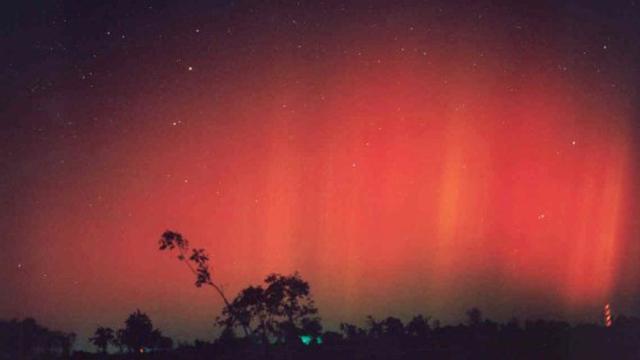Spotting the Northern Lights anywhere would probably be one of most notable experiences in a space fan’s life. Now imagine if it was China or Japan a thousand years ago and you didn’t know what caused these light shows. Odds are, you’d freak out a little bit… and write about it.
Aurora in TX from the 2003 solar storm (Christie Ponder)
That’s what a team of Japanese scientists are hoping. They are browsing through ancient documents to see what kinds of solar storms folks living back then saw and recorded. They think that some of these documented auroral events could be from “great magnetic storms” coming from strong solar events. If so, these texts could help us understand just how frequently these storms occur, seeing as they’d be far more harmful today given our reliance on electricity.

Image: NOAA
Auroral events come from blasts of particles from the Sun (especially electrons) interacting with the Earth’s atmosphere and magnetic field, exciting the oxygen and nitrogen and causing them to let out their characteristic glow. Certain solar events like coronal mass ejections (CMEs), large blasts originating from knots in the solar magnetic field, can cause particularly bad solar storms that could paralyse power grids, endanger astronauts, and deliver strong, days-long auroras.
The researchers found lots of examples of these observations. Take this one from Fujiwara-no-Sadaie (AKA Teika), the famous Japanese poet who mentioned prolonged storms on 21 and 23 February 1204 in his Meigetsuki:
On 1204/02/21, it was sunny. … After sunset, red vapour appeared in the direction of north and north-east. The lower part of red vapour was shaped like a rising moon and coloured white and bright. Its stripes extended faraway and was like smokes in fires. There were four or five of white parts and three or four of red vapours appeared. Is it neither cloud nor stands within clouds? Its light did not get darken and red light is mixed in the white light. It is nothing but a mystery. It is also very dreadful.
On 1204/02/23, it was sunny and quite windy. … In the time when to put a fire on the lamp, red vapour appeared in the north and north-east. It was like a distant mountain burning. It was very dreadful.
Chinese writings show descriptions of auroral events even earlier:
On 14 Feb. 937, at night, red and white vapours appeared alternately, like a cultivated and exploited bamboo forest, from 23:00 to 3:00, muddily from north to the middle in the sky, flickering unstably went around the 28 lunar mansions and disappeared at the dawn.
The researchers dug through all their examples to ensure they could find clusters of descriptions like these happening around the same time, and then compared their events to known changes in solar activity in their paper published last month in the journal Space Weather. They found that none of these descriptions occurred during times when they already knew the Sun’s activity was at a minimum, for example, and most of the events occurred during activity maximums. They concluded that these writings were probably about solar storms, and that these solar storms were probably the result of multiple coronal mass ejections in a short period of time.
This isn’t the first time scientists have looked at ancient texts for astronomical events. Some have looked through Egyptian as well as Hellenic texts for eclipses, and the paper’s authors have been looking for solar events in these Chinese and Japanese documents for a while. But now they’re really beginning to dig into these texts and what their details tell us about solar events, like how frequently the Earth might suffer from a great magnetic storm.
And other scientists thought the work was really interesting. “I think it’s cool, original research,” Scott McIntosh, director of the High Altitude Observatory at the National Center for Atmospheric research (NCAR), told Gizmodo in the email. “Awesome that they are trying to shed light on the dark ages ;-)”
Orkan Umurhan, research scientist at the NASA Ames Research Center, found the research “*very interesting*” and passed along some thoughts about the paper:
…In the showcase piece, the observer was living around 1204. This was the height of European medieval culture (Constantinople was busy getting sieged by the 4th Crusades, etc.). Since many of the northern cities should have been able to see this, I wonder if there is written documentation of these varied events.
Additionally, I am wondering if similar observations in this stretch of time (900-1200) are present in the documents written by Muslim/Arab/Central-Asian scientist, working in both in the big cities along the silk road, (e.g. Khorusan, latitude 33N) and in the cultural hub of Baghdad (latitude 35N). To me, this would be a nice corroboration to do: A project for someone to go hunt down and see what the Muslim scientists were saying about all of this. I know for a fact that the vast majority of the writings of the major Arab/Central-Asian/Persian scientists from that era are still largely untranslated…
All in all, he hoped to see more corroboration with other sources and more cross-cultural cooperation on this “historical detective story”.
It’s unlikely we’ll ever know for sure whether or not these writings actually describe solar storms — this is all pretty speculative, even if these are accurate descriptions of what the events should look like. However, this research does provide some more observations of events that don’t happen too frequently. The last major solar storm, for example, was probably the one that struck almost 15 years ago and caused power outages as well as aircraft rerouting, according to NASA (another less powerful storm struck in 2006).
All that is to say, understanding these storms might help us understand their impacts and predict when the next big one will strike.
